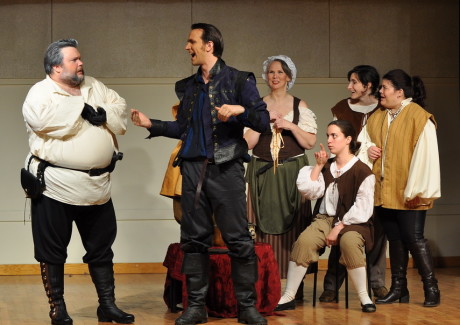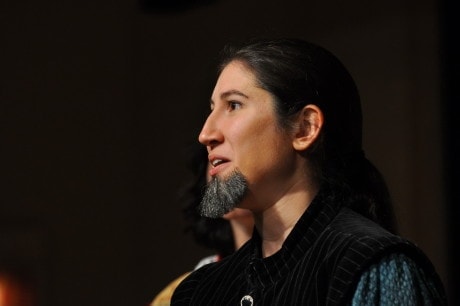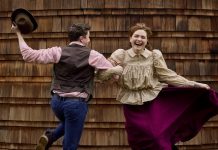The Britches and Hose Shakespeare Company is just the sort of grass roots, do-it-yourself theatrical troupe one might have hoped the nation would be awash in, but isn’t. Their Henry IV, Part 1, directed by Relle Seidman, plays this weekend in Fairfax and Vienna. As best befits Shakespeare, the production is one of simple, pared-down fun, with actors who are enthusiastic and overall quite good, and – thank heavens – not afraid to play large.

Although Henry IV is a something of a historical thriller, it is memorable far more for its characters than its plot, which centers on one of those rebellions that used to occur with frequency in English history, when powerful nobles would find themselves at odds with the reigning king.
In this case, the uprising has been sparked in Wales, a land long chaffing under foreign English rule. There are battles, there are prisoners, there are offences taken, deals made, the switching of sides, et cetera. However, the main focus of the action is less on the grand sweep of things, which in this play (though not in the series of which it is a part) serves as backdrop more than subject, than on a set of relationships that are also rivalries, which have Prince Hal (Dave Joria) – the king’s son, soon himself to be Henry V, who spends most of his time in taverns in the base company of Sir John Falstaff (Jay Tilley), a fallen knight, and his ragamuffin companions — at their center.
The production, as I mentioned, is very spare and reminiscent of Shakespeare’s own staging conditions. These were the conditions for which the plays were written and they not only work well, they are the ideal way to produce Shakespeare. The scenery is not onstage but in the mind. The Britches & Hose production team has scrounged up or made costumes and the necessary props (a throne, a pillow, a tavern table, and so forth), which are effective and in many cases stylish, though not elaborate, and which to the layman at least do a fine job suggesting the late medieval historical context.
This is a historical epic, so the cast of characters (and actors) is rather large, with a number of fine performances. These can more or less be divided into three main groups.
First comes the group centered around Falstaff and his tavern crew of ne’er-do-well drunks and robbers. Prince Hal belongs to this group, somehow at once both at the center (with Falstaff, a great frenemy) and at the periphery (he’s better than that, but wants to have his fun). Hal is a complex character with many motivations, levels, sides playing together all at once – Machiavellian but reckless, neither noble nor base yet aping both, a loving son though a thankless, resentful one, and so forth. He is a highly intelligent figure, mercurial, playful, manipulative, and – disturbing but likeable. Dave Joria, in an energetic, charismatic performance, captures all this excellently well; and his diction (a pet fixation of mine in Shakespearean performances) is intelligible, audible, unforced and captures both the poetry and the casualness of conversation.
Jay Tilley makes a lovely Falstaff; he is the kind of funny actor who has the largeness of both girth and stage presence to successfully perform the role, one of the greatest ever written whether by Shakespeare or anyone else. Tilley’s Falstaff is a genial clown – the darker, more threatening, perhaps cruder and brasher undertones with which the character can be played are largely absent here – and like the best clowns, he makes a kind of sense in his nonsense.
The relationship of friendly rivalry between Hal and Falstaff is legendary, as they are one of the most memorable pairs of the stage. What surprised me in this production was the strength of the Poins character, played with a good deal of presence and vive by Betsy Ryan. In the first half of the play, she, Joria, and Tilley make a kind of triad.
The second group of characters features the rebels, often at the Welsh court. Hotspur is of course the great role here, which after a bit of a slow start Sarah Pfanz more or less hits out of the park. Her Hotspur is more a smoldering coal than a blazing fire, a person whose martial seriousness and unwavering focus leave no room for chilling out, sitting back or laughing, all of which is very comic indeed. Pfanz’s portrayal is both funny and touching, and when her great warrior is slain by the not-yet-great Joria, one is genuinely sorry for it.
Also in this group are Owen Glendower (Gabriel Komisar) and the Earl of Douglas (Lorenzo Soto), two over-the-top Celtic noblemen who provoke what are probably the biggest laughs of the evening. Soto’s Scotchman is so tall, sunny, and accented that he mesmerizes every time he steps on stage, and you will die when he opens his mouth – impossible not to like. Komisar’s fiery Welshman is played so broadly, so intensely, with such gestures and such – well, you will just have to see it. If you are like me, you will be holding your sides laughing, and maybe snorting through the nose.
The title role, Henry IV, the great man of action and able king, is played by Stephanie Ramsey. She sports a horse-hair ponytail, a crown, and a pasted on goatee that somehow combine to be – kingly. Ms. Ramsey does a very good job, she captures the regal pride, the clinging ambitiousness of the resolutely practical man, the solicitude and hurt of a somewhat spurned, somewhat ashamed father, et cetera. In her case, as with Pfanz’s Hotspur, there is a kind of vocal power that does not project too well in a higher register, which is my only reservation about the gender-blind casting, otherwise so nearly invisible. The production does not play up cross-gender playing at all, which is what makes it work.

According to their website, the Britches and Hose Theater Company is “a gender-blind theater group, devoted to creating innovative and unexpected productions of public domain works.” If only there were more groups like them! By all means, go to see Henry IV, Part 1 this weekend, if you can make it. And at the very least, catch their version of Shaw’s Heartbreak House in April.
Henry IV, Part 1 plays from January 29-31, 2016. Performances on Saturday, January 30th will take place at 8:00 PM at Green Acres Hall – 4401 Sideburn Road, in Fairfax, VA.. The performance on Sunday, January 31, 2016 will take place at 4:00 PM at our originally scheduled venue, Green Hedges School – 415 Windover Avenue, in Vienna, VA. Tickets are $10 at the door.
LINK:
Meet The Cast of Britches and Hose Shakespeare Company’s ‘Henry IV’: Dave Joria, Sarah Pfanz, Stephanie Ramsey, and Jay Tilley
RATING:
Also, you might want to watch this trailer of Orson Wells’ Chimes at Midnight, a partial adaptation of the Henry IV/V plays, with a focus on Falstaff and Hal.





